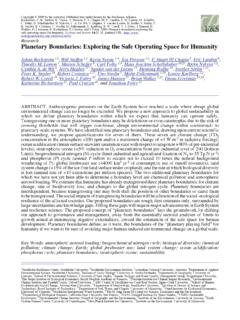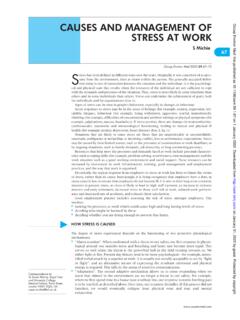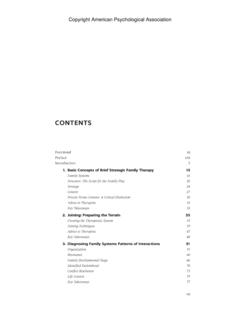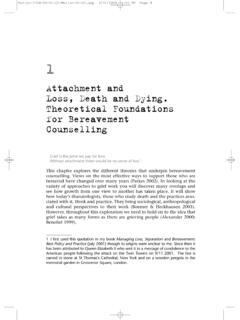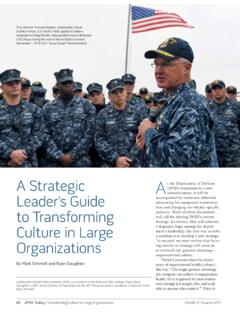Transcription of Applying resilience thinking - Stockholm Resilience Centre
1 PARTNER WITHA pplying Resilience thinking Seven principles for building Resilience in social-ecological systems23 Content:Introduction page 3 PRINCIPLE 1 Maintain diversity and redundancy page 4 PRINCIPLE 2 manage connectivity page 6 PRINCIPLE 3 manage slow variables and feedbacks page 8 PRINCIPLE 4 Foster complex adaptive systems thinking page 10 PRINCIPLE 5 Encourage learning page 12 PRINCIPLE 6 Broaden participation page 14 PRINCIPLE 7 Promote polycentric governance systems page 16 Glossary page 18 Useful reading page 19 THIS PUBLICATION WAS WRITTEN BY: Sturle Hauge Simonsen, Reinette (Oonsie) Biggs, Maja Schl ter, Michael Schoon, Erin Bohensky, Georgina Cundill, Vasilis Dakos, Tim Daw, Karen Kotschy, Anne Leitch, Allyson Quinlan, Garry Peterson, Fredrik CONTRIBUTORS:Marty Anderies, Derek Armitage, Jacopo Baggio, Elena Bennett, Duan Biggs, rjan Bodin, Katrina Brown, Shauna BurnSilver, Nathan Engle, Louisa Evans, Christo Fabricius, Carl Folke, Victor Galaz, Line Gordon, Chanda Meek, Ciara Raudsepp-Hearne, Martin Robards, Lisen Schultz, Brian Walker, Paul DESIGN: Matador Kommunikation and AzoteFRONT PAGE IMAGES:AZOTE IMAGES23 IntroductionA Resilience approach to sustainability focuses on how to build capacity to deal with unexpected change.
2 This approach moves beyond viewing people as external drivers of ecosystem dynamics and rather looks at how we are part of and interact with the biosphere the sphere of air, water and land that surrounds the planet and in which all life is found. One of the main ways in which people depend on and interact with the biosphere is through their use of different ecosystem services, such as the water we use for cooking and drinking, the crops we grow to nourish ourselves, regulation of the climate and our spiritual or cultural connections to ecosystems. People also change the biosphere in a myriad ways through activities such as agriculture, and building roads and cities. A Resilience thinking approach tries to investigate how these interacting systems of people and nature or social-ecological systems can best be managed to ensure a sustainable and resilient supply of the essential ecosystem services on which humanity publication is a popular summary of the book Principles for Building Resilience : Sustaining Ecosystem Services in Social-Ecological Systems , published by Cambridge University Press (2014).
3 This book, in turn, expands on the comprehensive review Towards principles for enhancing the Resilience of ecosystem services published in the journal Annual Reviews of Environment and Resources (2012). Both these publications reviewed and assessed the different social and ecological factors that have been proposed to enhance Resilience of social-ecological systems and the ecosystem services they produce. They present a set of seven principles that are considered crucial for building Resilience in social-ecological systems and discuss how these principles can be practically applied. The seven principles are 1) maintain diversity and redundancy, 2) manage connectivity, 3) manage slow variables and feedbacks, 4) foster complex adaptive systems thinking , 5) encourage learning, 6) broaden participation, and 7) promote polycentric governance systems. In the following pages, each principle is presented along with an example of how it has been applied. Of course, there are no panaceas for building Resilience .
4 Indeed, all the principles presented here require a nuanced understanding of how, where and when to apply them, and how the different principles interact and depend on one another. Before Applying any of the principles, it is essential to consider what you want to build Resilience of, and to what ( fires, floods, urbanization). Simply enhancing the Resilience of the existing ecosystem services in a landscape can entrench and exacerbate inequalities, such as where poor urban communities suffer the effects of flooding caused by agriculture or forestry activities on privately owned land upstream. Important trade-offs exist between different ecosystem services ( crop production and biodiversity), and it is not possible to enhance the Resilience of all ecosystem services simultaneously. With these caveats in mind, the seven principles provide guidance on key opportunities for intervening in and working with social-ecological systems to ensure that they remain resilient and able to provide the ecosystem services needed to sustain and support the well-being of people in a rapidly changing and increasingly crowded the past decades, few concepts have gained such prominence as Resilience , the capacity of a system to deal with change and continue to develop.
5 There has been an explosion of research into ways to promote or undermine the Resilience of various systems, be it a landscape, a coastal area or a city. However, the multitude of suggested factors that enhance Resilience has led to a somewhat dispersed and fragmented understanding of what is critical for building Resilience and how an understanding of these factors can be applied. 45 Principle oneMaintain diversity and redundancy In a social-ecological system, components such as species, landscape types, knowledge systems, actors, cultural groups or institutions all provide different options for responding to change and dealing with uncertainty and farmers often plant several different food crops so that failure of any one crop will not have catastrophic impacts on food provision. Similarly, natural resource harvesting systems, which target a number of different species, are more resilient than systems which target single species. Evidence from several other fields of study suggests that systems with many different components are generally more resilient than systems with few components.
6 Functional redundancy, or the presence of multiple components that can perform the same function, can provide insurance within a system by allowing some components to compensate for the loss or failure of others. In short, redundancy is embodied in the saying don t put all your eggs in one basket .Redundancy is even more valuable if the components providing it also react differently to change and disturbance. This is what we call response diversity (differences in the size or scale of the components performing a particular function give them different strengths and weaknesses, so that a particular disturbance is unlikely to present the same risk to all components at once). For example, seed dispersal in Ugandan forests is performed by a range of different-sized mammals, from mice to chimpanzees. While the small mammals are negatively affected by local disturbances, the larger, more mobile species are not and can therefore maintain their function as seed dispersers.
7 Within a governance system, a variety of organisational forms such as government departments, NGOs and community groups can overlap in function and provide a diversity of responses, because organisations with different sizes, cultures, funding mechanisms and internal structures are likely to respond differently to economic and political changes. Diverse groups of actors with different roles are critical in the Resilience of social-ecological systems, as they provide overlapping functions with different strengths. In a well-connected community, where functions overlap and redundancy is present, creativity and adapt-ability can diversity of users and managers can also safeguard the sustainable use of a resource. For example, within fishing communities, people of different ages, genders and financial means may favour different fishing methods and types of gear. This diversity enhances the ability of the whole community to detect and understand ecological changes because each user has a perspective on a different part of the system.
8 Investment in diversity and redundancy can enhance the Resilience of people s livelihoods because it enables people to adjust in response to changes in the market or the environment. For example, a substantial number of farm-ers in the drier parts of South Africa and Namibia have shifted from cattle ranching to wildlife ecotourism in response to a growing market preference for cultural ecosystem services. Farmers are more easily able to make this switch if the natural biodiversity on their farms is relatively intact. 45 Principle oneMaintain diversity and redundancy How can we maintain diversity and redundancy?Management can and should recognize and incorporate the value of diversity and redun-dancy in the management of social-ecological systems in order to build Resilience . This can be achieved by paying attention to the following aspects:Conserve and value redundancy. Redundancy is seldom explicitly conserved or managed, but is just as important as diversity in pro-viding Resilience .
9 Particular focus should be paid to important functions or services with low redundancy, such as those controlled by key species or actors. In some cases it may be possible to increase the redundancy associated with these ecological diversity. Biodiversity is essential for ecosystem services such as pollination, pest control, nutrient cycling and waste assimilation. In addition, natural biodiversity can improve the Resilience of these services by providing a reservoir of redundancy and response diversity and by reducing the dependence of agricultural sys-tems on external inputs of fodder, fertilizers and pesticides. Strategies for maintaining or enhancing ecological diversity include main-taining structural complexity in landscapes, establishing buffers around sensitive areas, creating corridors for connectivity and con-trolling overabundant invasive species. In an urban context, green infrastructure in the form of vegetated open space networks can be a more resilient way of providing ecosystem services such as storm water man-agement, compared to grey infrastructure such as concrete diversity and redundancy into gov-ernance systems.
10 Organisations need to recognise and better incorporate the value of diverse sources of knowledge. Provided this is balanced against costs and the risk of con-flicting agendas, a diversity of perspectives can improve problem solving and support both learning and innovation. This can al-low for quicker recovery after a disturbance. Focus less on maximum efficiency, even if it costs more. Conventional economic think-ing promotes maximum efficiency, while Resilience thinking encourages policies that can better cope with ecological, market or conflict-related shocks. Alternative develop-ment programmes can be guided by princi-ples of disparity and response diversity. For example, in farming communities livelihood options that are dissimilar to farming, such as a tourism-related activities rather than alternative types of farming, will provide greater response diversity and thus resil-ience to shocks. Specific incentives can be created to encourage such diversification at the individual farmer messageSystems with many different components ( species, actors or sources of knowledge) are generally more resilient than systems with few components.

